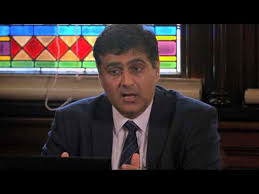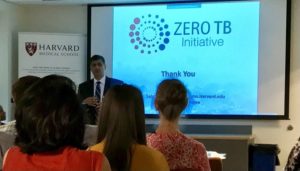by Brittany Stopa
Brittany Stopa is a Clinical Research Regulatory Coordinator in the BWH Department of Neurosurgery, and she holds a Masters of Public Health in Global Health. She is a contributor to the BWH Global Health Hub.

The BWH Global Health Delivery Partnership Grand Rounds, offered monthly, are open to all staff and clinicians at BWH. I attended the September 2017 Grand Rounds where Dr. Salmaan Keshavjee captivated an audience of global health and health equity supporters with his talk about the Zero TB Initiative. In addition to his appointment as Associate Professor in the BWH Division of Global Health Equity, Dr. Keshavjee serves as Director of Harvard Medical School Center for Global Health Delivery-Dubai and Associate Professor in the Department of Global Health and Social Medicine, at Harvard Medical School.
Dr. Keshavjee had our attention immediately when he declared that there are 10.4 million new cases of tuberculosis (TB) each year, but only 6.1 million of them are diagnosed and treated. Further, 1.8 million of those cases result in death each year, making TB the biggest infectious killer of adults globally. That’s a staggering 4,000 people each day that die from TB, a disease that has been treatable since 1947.
“TB is the biggest infectious killer of adults globally. A staggering 4,000 people each day die from TB, a disease that has been treatable since 1947.”
The global fight against tuberculosis has been painfully slow to progress. As he described the situation, in the past 25 years, we’ve seen only a 1.5% drop in incidence each year. At this rate, he tells us, it would take 200 years for the global incidence of TB to drop to US levels.
Anticipating the collective thought of his audience, Dr. Keshavjee went on to explain why this is still a problem after so long. He explained that while tuberculosis can be a difficult disease to address, we should be further along than we are. But we haven’t made the progress because we lack alignment of biological, social, and political strategies to address TB.
For a long time, there has been widespread endorsement of an intervention called DOTS, or Directly Observed Treatment Short Course. The DOTS intervention consists of 5 parts: (1) Sustained political and financial commitment, (2) Diagnosis by quality ensured sputum-smear microscopy, (3) Standardized short-course anti-TB treatment given under direct and supportive observation, (4) A regular uninterrupted supply of high quality anti-TB drugs, and (5) Standardized recording and reporting.
As an outside observer, I would have assumed this to be a comprehensive approach because it addresses the problem from many angles. But as a seasoned global health and social medicine expert, Dr. Keshavjee explained to us that the DOTS program is rife with insufficiencies. These programmatic gaps include a lack of patient finding and health system strengthening, a lack of focus on children and people living with HIV (TB continues to be the number 
one killer of people with HIV), and a lack of attention to the patients with latent TB. A minimalist plan was chosen because it’s less expensive.
On the topic of not treating patients with latent TB because of the cost, he explained, “DOTS didn’t include any of that, it was seen as too complicated. In fact, the idea of treating people who had this so-called latent [TB] disease had been around since the late 1950s. And the WHO had determined in 1964 that it was too complicated to do in poor countries, because it would cost too much and they didn’t have the wherewithal. They brought experts again in 1974 who came to the same conclusion. And they brought together experts again in 1982 who came to the same conclusion, that it was just too hard for poor countries. So a lot of these things that came into DOTS, and the decisions about what to leave out, were not based on science.”
He told us that it’s not impossible to treat TB in developing countries. In fact, he cited case studies in locales as diverse as Alaska, New York City, Singapore, and Russia, where a TB intervention was successfully implemented. It’s simple: we have the data needed to formulate a comprehensive TB treatment plan across a city or country. The difficult bit is getting all the necessary actors to buy in and support the effort. But it is possible.
Dr. Keshavjee believes that with a comprehensive approach to this multimodal epidemic, it’s possible to eliminate TB. In 2012, The Zero Declaration was signed, which marked the beginning of a new era of TB programs. Signatories to The Zero Declaration committed to zero deaths, zero stigma, and zero new infection, and they did it for three reasons: (1) TB is both preventable and curable if the right epidemic control strategy is used, (2) The main driver of the unnecessary burden of TB is lack of political will to implement a comprehensive epidemic control strategy, and (3) Every country has the potential to reach Zero TB if they use the correct, tried and tested, strategy.
Doing his part, Dr. Keshavjee is working on a new project to change the thinking about and strategy for addressing TB. In the series that he led in The Lancet, he discussed how we can eliminate TB, and his approach considers several key elements. The approach needs to be data driven, and it needs to include active case finding. It needs to use the correct treatment to stop transmission, it must treat latent TB, and it must employ prevention methods. And finally, it needs to incorporate the support systems surrounding the healthcare system in order to achieve the best and most sustainable results.
The Zero TB Initiative is offering a consulting and programming partnership with those cities whose governments are ready to commit to a comprehensive TB program. With the successes that this young program has had, it continues to attract more cities for its TB programming. And with the growing reputability of the Zero TB Initiative, the possibility for a comprehensive plan begins to look feasible, where it was once believed that only a discounted program could be implemented. Thanks to the work of Dr. Keshavjee and the team at Zero TB Initiative (which has a secretariat run by a non-profit, Advance Access & Delivery), we may see an end to tuberculosis in our lifetime.
Reflecting on his talk, it is clear that we can no longer we accept a different strategy for TB apportioned by socioeconomic status or national origin. Health is a human right. And if we are to embrace that central tenet of public health, then we cannot accept a different TB strategy for rich versus poor countries. Every country deserves to use the most well-proven and biologically-sound strategy for eradicating TB. It doesn’t mean that it has to be the most expensive care; it means that it has to be the correct strategy based on the science that we have available. That has not been done to date, and it’s the only way that we can hope to achieve TB elimination.
For additional information and further reading, please visit the following websites, which provide resources and education on this important issue. You can support the work of Zero TB Initiative at www.zerotbinitiative.org.
References:
https://www.zerotbinitiative.org/
http://www.searo.who.int/tb/topics/what_dots/en/
http://ghsm.hms.harvard.edu/person/faculty/salmaan-keshavjee
http://www.tbonline.info/posts/2012/9/7/zero-declaration/
http://www.thelancet.com/series/how-to-eliminate-tuberculosis
